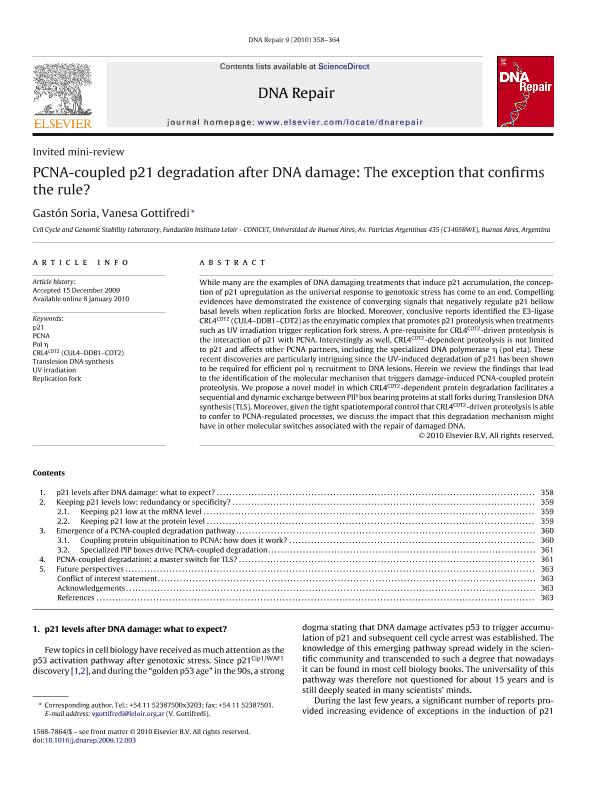Artículo
PCNA-coupled p21 degradation after DNA damage: The exception that confirms the rule?
Fecha de publicación:
04/2010
Editorial:
Elsevier Science
Revista:
Dna Repair
ISSN:
1568-7864
Idioma:
Inglés
Tipo de recurso:
Artículo publicado
Clasificación temática:
Resumen
While many are the examples of DNA damaging treatments that induce p21 accumulation, the conception of p21 upregulation as the universal response to genotoxic stress has come to an end. Compelling evidences have demonstrated the existence of converging signals that negatively regulate p21 bellow basal levels when replication forks are blocked. Moreover, conclusive reports identified the E3-ligase CRL4(CDT2) (CUL4-DDB1-CDT2) as the enzymatic complex that promotes p21 proteolysis when treatments such as UV irradiation trigger replication fork stress. A pre-requisite for CRL4(CDT2)-driven proteolysis is the interaction of p21 with PCNA. Interestingly as well, CRL4(CDT2)-dependent proteolysis is not limited to p21 and affects other PCNA partners, including the specialized DNA polymerase eta (pol eta). These recent discoveries are particularly intriguing since the UV-induced degradation of p21 has been shown to be required for efficient pol eta recruitment to DNA lesions. Herein we review the findings that lead to the identification of the molecular mechanism that triggers damage-induced PCNA-coupled protein proteolysis. We propose a novel model in which CRL4(CDT2)-dependent protein degradation facilitates a sequential and dynamic exchange between PIP box bearing proteins at stall forks during Translesion DNA synthesis (TLS). Moreover, given the tight spatiotemporal control that CRL4(CDT2)-driven proteolysis is able to confer to PCNA-regulated processes, we discuss the impact that this degradation mechanism might have in other molecular switches associated with the repair of damaged DNA.
Palabras clave:
P21
,
Pcna
,
Pol Eta
,
Crl4cdt2 (Cul4–Ddb1–Cdt2)
Archivos asociados
Licencia
Identificadores
Colecciones
Articulos(IIBBA)
Articulos de INST.DE INVEST.BIOQUIMICAS DE BS.AS(I)
Articulos de INST.DE INVEST.BIOQUIMICAS DE BS.AS(I)
Citación
Soria, Ramiro Gaston; Gottifredi, Vanesa; PCNA-coupled p21 degradation after DNA damage: The exception that confirms the rule?; Elsevier Science; Dna Repair; 9; 4; 4-2010; 358-364
Compartir
Altmétricas




